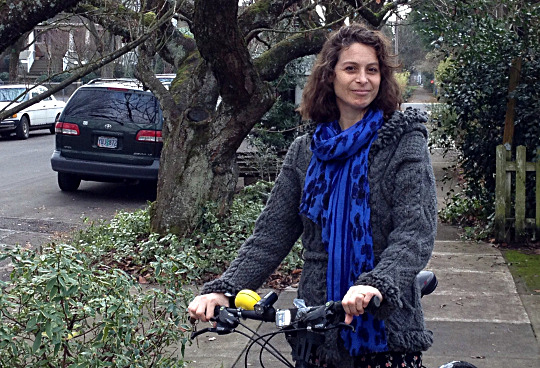When lifestyle columnist Cathy Hastie’s job pushed her to switch to a car commute for the first time, we wondered if it’d change her perspective on getting around. Here’s what she’s concluded from the first month.
I have recently rediscovered that the typical car is much more than what I remembered it to be. The car serves a multitude of purposes that have become essential in the modern world.
For example, the average workplace doesn’t provide a private place to eat lunch, make personal calls or take a nap, let alone have a cigarette, watch an episode of “Archer,” or ogle the Sports Illustrated Swimsuit edition (not necessarily in that order). What better place to perform these important lunch-hour tasks than inside your parked car, anonymous amongst thousands of others, ordered and sorted in the acre-wide company parking lot? The car gives us the isolation that our gadget-driven culture demands and our efficiency-oriented employers force upon us. It even serves as a makeshift hotel room for those frenzied moments of desire that can’t wait.
It really does make the world turn, from the hundreds we spend on auto repairs to the fitness club membership we are obligated to buy.
The car is a great place to store garbage. Instead of using the receptacle way across the parking lot, the backseat floor works just fine as a temporary home for burger wrappers, parking tickets and empty adult beverage containers. It also does a great job of storing bags of Goodwill donations, that sweater to be returned at the store, and the Christmas inflatable borrowed from your sister. Delivery errands can be put off for months when the items are all crammed into the trunk, invisible and forgotten.
The car is also a great economic stimulator. It really does make the world turn, from the hundreds we spend on auto repairs to the fitness club membership we are obligated to buy because we have gained 20 pounds from sitting on our asses while driving an hour and a half every day back and forth to work. Gas money funds far more than the weekend partying of the corner store gas station attendant. It buys politicians, bankrolls foreign despots and funds wars – always a profitable endeavor for someone.
Even therapists see financial benefit directly related to the car and its use. The car screws with our heads. It encourages vanity, but shames us mercilessly. Like it or not, it serves as a calling card, an Avatar, and a symbol of the driver inside. Our image to other drivers on the road is wrapped up in the size of our ride, the shininess of our grille, the eternal youthfulness of the latest, sexiest model. Forcing us to keep up appearances, the car inspires us to embrace peer pressure, compete for attention and try to impress upon the world how awesome we are, all while wearing mustard-stained sweats and a sweaty baseball cap behind its tinted windows.
The car makes us independent — so independent that we can drive 45 minutes to work in a neighboring city every day for a month without knowing a single thing about the place.
The car pumps us up with bravado, then turns around and humiliates us as we sit in mile-long traffic jams, making us feel like insignificant sheep, following the car-commuting herd. Powerless behind the steering wheel, we endure boredom, anxiety, unpredictability and impatience on the inescapable auto-Alcatraz of the freeway during rush hour. Solitary and frustrated in a sweltering, fume-emitting metal box, who wouldn’t need a little therapeutic venting? It blows away our calm. It eats away at our pride. The car is a malicious trickster, wooing us with its allure of promised studliness and then slapping our widening cellulite thighs in cruel mockery.
The car makes us independent — so independent that we can drive 45 minutes to work in a neighboring city every day for a month without knowing a single thing about the place, its people, or what happens there. We use the unexplored city without connecting to it. The car distances us physically from the place we call home, so we ignore the community where we spend 8 hours a day. As a car commuter, we just don’t care.
The car inspires efficiency. It puts the destination ahead of the journey. With GPS and a seemingly endless supply of combustion-driven energy, we are not limited by how far we can go without asking for directions or stopping for a milkshake at the roadside diner. Driving alone becomes an empty chore to get us to a point on a map. The surrounding communities are hidden beyond noise-barrier walls that line the Interstate. Everything but the flashing dot on Google maps is invisible to us. The car makes us forget that, wherever we go, there are children playing, dogs barking, lovers meeting. We just pass on by.
— Read Cathy’s past columns here.


